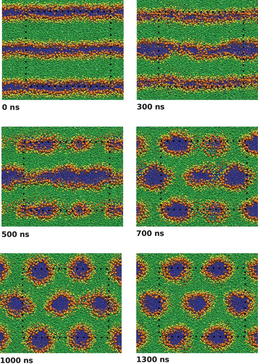Simulation of biological systems at long length and distance scales
- Research Team
- Kieran Selvon
- Investigators
- Jonathan Essex

Spontaneous formation of inverse hexagonal phase using a coarse-grain membrane model. Trajectory snapshots from a simulation of 1024 DOPE lipid molecules and 9216 water particles. Lipid head particles are orange, glycerol and ester particles are yellow, t
Biological systems are notoriously complex and difficult to understand. They span distance scales across nine orders of magnitude ranging from individual small molecules (1 nm) to whole organisms (1 m), and times scales of 21 orders of magnitude from individual bond breaking in an enzyme (1 ps) to the human lifetime (2 Gs). While there are many computer modelling approaches available to understand a particular length and timescale, the linking of these methods remains an unsolved challenge. This PhD project will work to address this problem at the molecular level, with a particular emphasis on solving real biological problems, specifically the mechanism of diffusion and drug permiation across biological membranes.
The project will seek to address the challenges of modelling large-scale self-assembly of biological membranes, how membrane composition affects the biological function of embedded proteins, how changes in protein conformation regulate protein function, particularly in the context of protein-protein interactions, and how seemingly simple changes in pH or ionic concentration affect membranes, proteins and DNA. The CDT in NGCM has long-standing collaborations with the pharmaceutical industry, and linking drug discovery to solving these problems is one ultimate goal of the project.
To address these challenges two broad approaches will be taken. The first involves combining different scales of model in either separate or combined simulations in multi scale modelling. The second involves finding approaches to accelerate slow events in the simulations by 'enhanced sampling methods'. Ultimately we wish to combine these two techniques. In both approaches the project will build on existing research. For example there are multi-scale models of biological membranes which allow the simulation of drug permeation through cellular barriers. Extending these models to include whole-proteins in mixed component membranes is currently underway. To enhance sampling in proteins, approaches have been developed to increase the velocities of low-frequency vibrations. This is effectively frequency-dependent heating, and has been shown to significantly improve the sampling of flexible loops. In this PhD project we will further develop and extend these and related methods, to target specific biological problems, with particular emphasis on drug permeation and general diffusion across cell membranes.
Categories
Life sciences simulation: Bioinformatics, Biomathematics, Biomedical, Biomolecular Organisation, Biomolecular simulations
Physical Systems and Engineering simulation: Diffusion
Algorithms and computational methods: Density functional Theory, Molecular Dynamics, Monte Carlo, Optimisation, statistical analysis
Programming languages and libraries: C, Fortran, IPython/Jupyter Notebook, Matlab, Python
Computational platforms: Mac OS X, Windows
Transdisciplinary tags: Medicine, NGCM, Scientific Computing